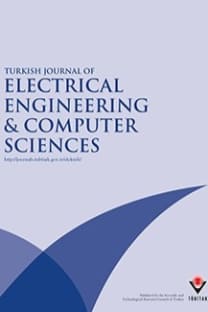A novel and efficient algorithm for adaptive filtering: Artificial bee colony algorithm
Artificial bee colony, Particle swarm optimization, Differential evolution, Adaptive filter design, Noise cancellation
A novel and efficient algorithm for adaptive filtering: Artificial bee colony algorithm
Artificial bee colony, Particle swarm optimization, Differential evolution, Adaptive filter design, Noise cancellation,
___
- Paulo S. R. Diniz, Adaptive Filtering Algorithms and Practical Implementations, Springer, USA, 2008.
- S. Haykin, Adaptive Filter Theory, Prentice Hall, USA, 2002.
- D. J. Krusienski, W. K. Jenkins, Design and performance of adaptive systems based on structured stochastic optimization strategies, IEEE Circuits Systems Magazine 5 (2005) 8-20.
- S. C. Ng, S. H. Leung, C. Y. Chung, A. Luk, W. H. Lau, The genetic search approach: A new learning algorithm for adaptive IIR Şltering, IEEE Signal Processing Magazine 13 (1996) 38-46.
- N. Karaboga, Digital IIR Şlter design using differential evolution algorithm, EURASIP Journal on Applied Signal Processing 8 (2005) 1-9.
- A. Kalinli, N. Karaboga, A parallel tabu search algorithm for digital Şlter design, COMPEL-The International Journal for Computation and Mathematics in Electrical and Electronic Engineering 24 (2005) 1284-1298.
- N. Karaboga, B. Cetinkaya, Design of digital FIR Şlters using differential evolution algorithm, Circuits Systems and Signal Processing Journal 25 (2006) 649-660.
- D. J. Krusienski, W. K. Jenkins, Adaptive Şltering via particle swarm optimization, 37thAsilomar Conference on Signals Systems and Computers, 2003, pp. 571-575.
- D. J. Krusienski, W. K. Jenkins, Particle swarm optimization for adaptive IIR Şlter structures, Congress on Evolutionary Computation, 2004, pp. 965-970.
- A. Kalınlı, N. Karaboga, A new method for adaptive IIR Şlter design based on tabu search algorithm, International Journal of Electronics and Communication 59 (2004) 1-7.
- S. Chen, B. L. Luk, Adaptive simulated annealing for optimization in signal processing applications, Signal Pro- cessing 79 (1999) 117-128.
- N. Karaboga, A new design method based on artiŞcial bee colony algorithm for digital IIR Şlters, Journal of the Franklin Institute-Engineering and Applied Mathematics 346 (2009) 328-348.
- A. P. Engelbrecht, Fundamentals of computational swarm intelligence, John Wiley & Sons Publication, Chichester, UK, 2005.
- D. Karaboga, An idea based on honey bee swarm for numerical optimization. Technical Report-TR06, Erciyes University, Engineering Faculty, Computer Engineering Department, 2005.
- D. Karaboga, B. Basturk, A powerful and efficient algorithm for numerical function optimization: ArtiŞcial bee colony (ABC) algorithm, Journal of Global Optimization 39 ( 2007) 459-471.
- R. S. Rao, S.V.L. Narasimham, M. Ramalingaraju, Optimization of distribution network conŞguration for loss reduction using artiŞcial bee colony algorithm, International Journal of Electrical Power and Energy Systems Engineering 1 (2008) 116-122.
- A. Singh, An artiŞcial bee colony algorithm for the leaf-constraint minimum spanning tree problem, Applied Soft Computing 8 (2008) 687-697.
- P. W. Tsai, J. S. Pan, B. Y. Liao, S. C. Chu, Interactive artiŞcial bee colony algorithm, International Symposium on Intelligent Informatics, 2008, pp. 247-251.
- S. Hemamalini, S. P. Simon, Economic load dispatch with valve-point effect using artiŞcial bee colony algorithm, 32thNational Systems Conference, 2008, pp. 17-19.
- T. Kurban, E. Besdok, A comparison of RBF neural network training algorithms for inertial sensor based terrain classiŞcation, Sensors Journal 9 (2009) 6312-6329.
- D. Karaboga, B. Basturk, ArtiŞcial bee colony (ABC) optimization algorithm for solving constrained optimization problems, LNCS: Advances in Soft Computing: Foundations of Fuzzy Logic and Soft Computing, 2007, pp.789-798. [22] B. Akay, D. Karaboga, Parameter Tuning for the ArtiŞcial Bee Colony Algorithm, Lecture Notes in ArtiŞcial Intelligence, 2009, pp.608-619.
- ISSN: 1300-0632
- Yayın Aralığı: Yılda 6 Sayı
- Yayıncı: TÜBİTAK
Neuro-fuzzy soft-switching hybrid filter for impulsive noisy environments
Line detection with adaptive random samples
Simulation of storage time versus reverse bias current for p+n and pin diodes
Mehmet Serhat KESERLİOĞLU, Hasan Hüseyin ERKAYA
Sequence alignment from the perspective of stochastic optimization: a survey
İhsan Ömür BUCAK, Volkan USLAN
A novel and efficient algorithm for adaptive filtering: Artificial bee colony algorithm
Nurhan KARABOĞA, Mehmet Bahadır ÇETİNKAYA
Cengiz Polat UZUNOĞLU, İbrahim GÜNEŞ, Mukden UĞUR
Stray magnetic field distributed around a PMSM
Ali Ahmed ADAM, Kayhan GÜLEZ, Selim KÖROĞLU
PAPR reduction using artificial bee colony algorithm in OFDM systems
Necmi TAŞPINAR, Derviş KARABOĞA, Mahmut YILDIRIM
Cooperative diversity with continuous phase modulation
Adaptive Wiener-turbo systems with JPEG & bit plane compressions in image transmission
